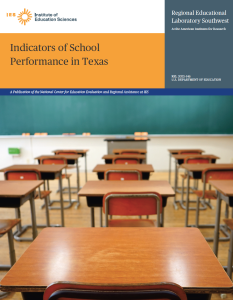

The School Improvement Division of the Texas Education Agency (TEA) identifies, monitors, and supports low-performing schools. To identify low-performing schools, TEA assigns annual academic accountability ratings to its districts and schools, but these ratings are only provided once per year and are vulnerable to disruptions in the assessment system. Schools that receive low accountability ratings do not meet accountability expectations and are considered low-performing.
TEA partnered with Regional Educational Laboratory (REL) Southwest to explore whether information regularly collected by districts and schools could be used to create indicators for monitoring low-performing schools. Using school-level data from the two school years preceding the pandemic (2017/18 and 2018/19), the study examined which student behaviors (such as attendance, coursetaking, and discipline) and teacher factors (such as years of experience and turnover) were associated with the performance of Texas schools on accountability measures that use assessment data.
The study found that several student behaviors and teacher factors were associated with the likelihood of schools meeting accountability expectations across school levels and could be used to identify whether a school was likely to meet accountability expectations. For elementary schools, these indicators included student attendance and chronic absenteeism; for middle school, these indicators included student attendance, chronic absenteeism, and discipline; and for high schools, these indicators included student coursetaking and teacher turnover. However, many of the indicators that identified schools that were likely to meet accountability expectations in 2017/18 and 2018/19 did not identify these schools as likely to meet accountability expectations in 2019/20, potentially due to structural changes during the pandemic (such as changes in how attendance was reported).
Staff at TEA can consider using these indicators to identify schools that are not likely to meet accountability expectations and may need extra support during a typical school year. The indicators are not intended to be used in the place of accountability ratings. Instead, they can provide information for TEA staff to identify schools in need of supports and help identify what supports to provide, for ongoing monitoring throughout the school year, and when accountability data are not available.
Online Availability



